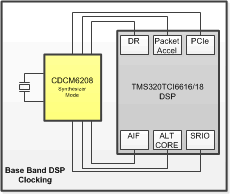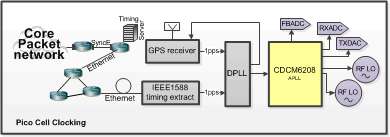ZHCSDT8 May 2015 CDCM6208V1F
PRODUCTION DATA.
- 1 特性
- 2 应用
- 3 说明
- 4 简化电路原理图
- 5 修订历史记录
- 6 Description (continued)
- 7 Pin Configuration and Functions
-
8 Specifications
- 8.1 Absolute Maximum Ratings
- 8.2 ESD Ratings
- 8.3 Recommended Operating Conditions
- 8.4 Thermal Information, Airflow = 0 LFM
- 8.5 Thermal Information, Airflow = 150 LFM
- 8.6 Thermal Information, Airflow = 250 LFM
- 8.7 Thermal Information, Airflow = 500 LFM
- 8.8 Single Ended Input Characteristics
- 8.9 Single Ended Input Characteristics (PRI_REF, SEC_REF)
- 8.10 Differential Input Characteristics (PRI_REF, SEC_REF)
- 8.11 Crystal Input Characteristics (SEC_REF)
- 8.12 Single Ended Output Characteristics (STATUS1, STATUS0, SDO, SDA)
- 8.13 PLL Characteristics
- 8.14 LVCMOS Output Characteristics
- 8.15 LVPECL (High-Swing CML) Output Characteristics
- 8.16 CML Output Characteristics
- 8.17 LVDS (Low-Power CML) Output Characteristics
- 8.18 HCSL Output Characteristics
- 8.19 Output Skew and Sync to Output Propagation Delay Characteristics
- 8.20 Device Individual Block Current Consumption
- 8.21 Worst Case Current Consumption
- 8.22 I2C TIMING
- 8.23 SPI Timing Requirements
- 8.24 Typical Characteristics
- 9 Parameter Measurement Information
- 10Detailed Description
-
11Application and Implementation
- 11.1 Application Information
- 11.2
Typical Applications
- 11.2.1
Design Requirements
- 11.2.1.1 Device Block-level Description
- 11.2.1.2 Device Configuration Control
- 11.2.1.3 Configuring the RESETN Pin
- 11.2.1.4 Preventing False Output Frequencies in SPI/I2C Mode at Startup:
- 11.2.1.5 Power Down
- 11.2.1.6 Device Power Up Timing:
- 11.2.1.7 Input Mux and Smart Input Mux
- 11.2.1.8 Universal INPUT Buffer (PRI_REF, SEC_REF)
- 11.2.1.9 VCO Calibration
- 11.2.1.10 Reference Divider (R)
- 11.2.1.11 Input Divider (M)
- 11.2.1.12 Feedback Divider (N)
- 11.2.1.13 Prescaler Dividers (PS_A, PS_B)
- 11.2.1.14 Phase Frequency Detector (PFD)
- 11.2.1.15 Charge Pump (CP)
- 11.2.1.16
Programmable Loop Filter
- 11.2.1.16.1 Loop Filter Component Selection
- 11.2.1.16.2 Device Output Signaling
- 11.2.1.16.3 Integer Output Divider (IO)
- 11.2.1.16.4 Fractional Output Divider (FOD)
- 11.2.1.16.5 Output Synchronization
- 11.2.1.16.6 Output MUX on Y4 and Y5
- 11.2.1.16.7 Staggered CLK Output Powerup for Power Sequencing of a DSP
- 11.2.2 Detailed Design Procedure
- 11.2.3 Application Performance Plots
- 11.2.1
Design Requirements
- 12Power Supply Recommendations
- 13Layout
- 14器件和文档支持
- 15机械、封装和可订购信息
1 特性
-
性能出色且功耗低:
- 低噪声合成器(265 fs-ms 典型抖动)或者低噪声抖动清除器(1.6 ps-ms 典型抖动)
- 0.5W 典型功耗
- 高度通道到通道隔离和出色电源抑制比 (PSRR)
- 通过灵活的 1.8V,2.5V 和 3.3V 电源,可定制器件性能,从而实现混合输出电压
- 灵活的频率规划:
- 支持与低压正射极耦合逻辑 (LVPECL) 相似的、CML、或者与低压差分信号 (LVDS) 相似的信令的 4x 整数向下分频差分时钟输出
- 支持主机时钟信号电平 (HCSL),与 LVDS 相似的信令、或者 8 个 CMOS 输出的 4x 小数或者整数分频差分时钟输出
- 小数输出分频器可实现 0ppm 至 <1ppm 的频率误差并且免除了对于晶体振荡器和其它是时钟生成器的需要
- 输出频率高达 800MHz
- 两个差分输入、XTAL 支持、智能开关功能
- SPI, I2C™,和引脚可编程
- 用于快速设计周转时间的专业用户图形用户界面 (GUI)
- 7 x 7mm 48 引脚四方扁平无引线 (QFN) 封装 (RGZ)
- -40 °C 85 °C 温度范围
2 应用
- 基带时钟(无线基础设施)
- 网络和数据通信
- Keystone C66x 多核数字信号处理器 (DSP) 时钟
- 存储服务器、便携式测试设备、
- 医疗成像、高端 A/V
3 说明
CDCM6208V1F 是一款多用途、低抖动低功耗频率合成器,此频率合成器能够利用特有低频晶振或 CML、LVPECL、LVDS 或 LVCMOS 信号的两路输入之一来生成八路低抖动时钟输出(输出可在类似于 LVPECL 的高摆幅 CML、正常摆幅 CML、类似于 LVDS 的低功耗 CML、HCSL 或 LVCMOS 中进行选择),广泛适用于各类无线基础设施基带、有线数据通信、计算、低功耗医疗成像以及便携式测试和测量应用。 CDCM6208V1F 还特有一种用于其中四路输出的创新型小数分频器架构,能够生成精度高于 1ppm 的任意频率。 CDCM6208V1F 可通过 I2C 或串行外设接口 (SPI) 编程接口轻松配置。在没有串行接口的情况下,器件还可以利用自身提供的引脚模式通过控制引脚设置为 32 种不同预编程配置中的一种。
器件信息(1)
| 器件型号 | 封装 | 封装尺寸(标称值) |
|---|---|---|
| CDCM6208V1F | VQFN (48) | 7.00mm x 7.00mm |
- 如需了解所有可用封装,请见数据表末尾的可订购米6体育平台手机版_好二三四附录。
4 简化电路原理图

